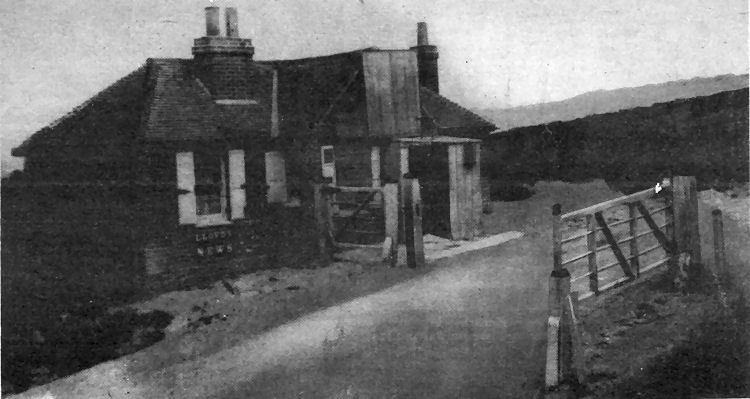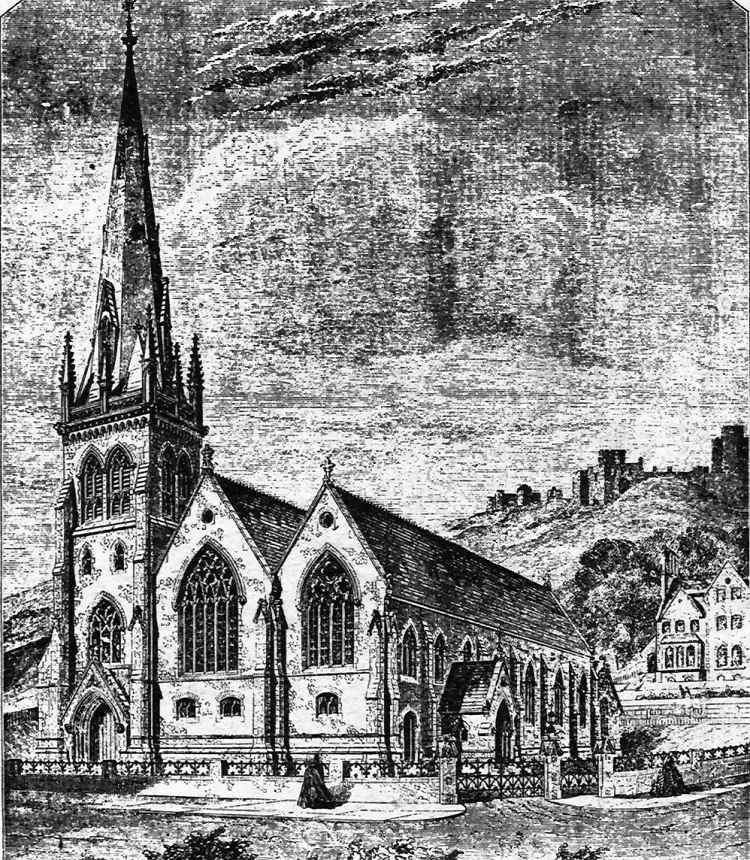Page Updated:- Sunday, 07 March, 2021. |
|||||
 Published in the Dover Express, 3 October, 1980. A PERAMBULATION OF THE TOWN, PORT AND FORTRESS. PART 119.
MR MOXON INTERVENES Meanwhile, Mr William Moxon, a man of bold initiative, came on the scene as the contractor for the town drainage, and large works of fortification at the Western Heights. He took the Maison Dieu Park in hand, and formulated a general scheme for widening Charlton Back Lane, planned a new road across the river into Biggin Street, and being in expectation of making a large fortune out of his various undertakings, both here and in London, reserved the greater part of the Maison Dieu Park above Pencester Road for his own use, and built there as his residence the Mansion still known as Brook House. The park, alongside the Back Lane, had been bounded by an ancient stone wall, which Mr Moxon threw down in 1860, and set back his handsome iron fence, according to the plan of Mr Rowland Rees, the then town surveyor, to give a 30ft. road all through. Some members of the town council were strongly in favour of 40ft, and ultimately that was in most parts obtained. In developing the upper part, above what used to be Messrs Clark’s nursery gardens opposite what is now the Health Centre entrance, the Woods and Forests Department co-operated. In January 1860, Messrs Cluttons, the land agents of the Crown, wrote to the town council urging immediate action. Soon after, building operations received a great stimulus by the erection of St James’ Church at the lower end of the road, and by the opening of Pencester Street and Park Street, affording additional connections with the centre of the town.
ST JAMES’ NEW CHURCH The foundation stone of St James’ New Church was laid on April 10, 1860, by J. P. Plumptre, Esq., Deputy Lord Warden, the mayor and Corporation attending in state to grace the ceremony. The Interest aroused was very great. Mr W. Moxon, the man of the hour, was the builder of the church, but, unfortunately, before he had completed it, financial difficulties overclouded his prospects, and the finishing was delegated to Messrs Fry and Pepper. The pinnacle of St James’ handsome steeple was fixed by the late Mr Steriker Finnis on July 25, 1861, and the building was consecrated by the Bishop of Sierra Leone on August 20, 1862. St James's Church was the principal building in Maison Dieu Road until damaged during the Second World War led to its demise and ultimate demolition. It was a very fine example of the Early Decorated style of Gothic architecture, from the designs of Mr Talbot Bury. Its cost was £10,000, and it provided accommodation for 1,400 persons. A magnificent contributor to the cost was Lady Morrison, of Snarebrook, who then lived in Waterloo Crescent. She gave nearly £4,000 and the stained glass of the west window recorded her liberality. The walls of the church, which was an impressive structure, were of Kentish
rag, with external dressings of Bath and internal of Caen stone. The length
of the church was 134ft. and its width 78ft., and it comprised
HOUSING PROGRESS The Town Council, in order to give the thoroughfare ample width in front of the new church, paid £250 to have the villas on the opposite side set back. The total amount borrowed for improving this road was £1000, which has long since been repaid. In 1862-3. builders were busy in the mid-section of the road. In 1862 the three handsome pairs of residences called Park Villas were erected; and in May, 1863. Mr J. N. Tunbridge commenced the two pairs of villas each side of Park Street; at the same time Messrs. Walker and Sons built the six semi-detached residences, called Camden Villas, between Godwyne Road and the nursery; and Mr W. Bull built villas on the opposite side. Within the next four years, that is, before the close of 1866, the road had been lined with villas, with the exception of the east side below the old nursery, where only one pair of houses, Temple Villas, had been erected. Johnson's promenade gardens had made a struggle for existence, and Johnson, the proprietor, dying, the land was bought by Captain Carlyon, and Mr C. H. Bur-bridge took part of it over and built the miniature Crystal Palace which once there. About 1866 Mr Philip Stiff bought the land between the glass house and the site of the Catholic Church, and in 1867 had built Maison Dieu Lodge and the next pair of villas below. At that time the Catholic Church was in the course of erection, but it was twenty years later before the remaining plots between the two churches were filled.
THE CATHOLIC CHURCH This attractive church in Maison Dieu Road, faces Pencester Road. It was built in the years 1867 - 8, and was the first permanent settlement of the Roman Catholics in Dover, although the Dover Mission had long before existed. It commenced in 1822, and Mass was said in a house at 45 Snargate Street. In 1834 Mass was said in a carpenter’s loft in St James’s Street, but the floor being weak, it became necessary to seek other quarters and the old Wesleyan Chapel in Elizabeth Square being then for sale it was purchased for £425; its restoration cost £400, and £350 was paid for a priest’s house adjoining. This chapel was first used by the Catholics in May, 1835. In 1860 the priest’s house was sold to the London, Chatham, and Dover Railway Company for £650. About that time the estate of the Countess de Front was devoted to Catholic charities, and with a portion of it the new Catholic Church was built and endowed on the Maison Dieu Road.

Dating back over 100 years this is a photograph of the old toll gate on Castle Hill which was demolished about 1878. It stood on the ridge of the hill a little above the present turning to Deal, the old turnpike road to Deal having turned rather sharply off the Guston road just beyond the brow of the hill. Just through the gate was Prescott’s Pond, on the site of which now stands the building erected as a sergeants’ mess for Connaught Barracks. The Prescotts farmed In the area for centuries and one of them was responsible for converting Captain Samuel Taverner who went on to become pastor of the local Baptist community. The name over the tollhouse is Thomas Munn. Above his name board is a large public notice, presumably about the turnpike and its tolls. One of the last residents at the toll house was a shepherd called “Cock“ Linnet who cared for sheep on the surrounding slopes but later became a Dover Corporation night watchman.

The engraving, above, bearing the names of B. Sly and W. E. Hodgkin, is of the New St. James’ Church. To the rear is what looks like St. James’ Hotel.
|
|||||
|
If anyone should have any a better picture than any on this page, or think I should add one they have, please email me at the following address:-
|
|||||
| LAST PAGE |
|
MENU PAGE |
|
NEXT PAGE | |